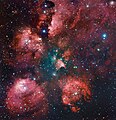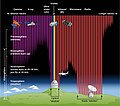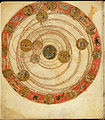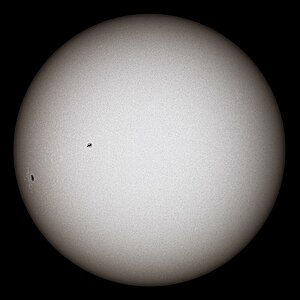
Summary
|
The Astronomy Portal
Introduction Astronomy is a natural science that studies celestial objects and the phenomena that occur in the cosmos. It uses mathematics, physics, and chemistry in order to explain their origin and their overall evolution. Objects of interest include planets, moons, stars, nebulae, galaxies, meteoroids, asteroids, and comets. Relevant phenomena include supernova explosions, gamma ray bursts, quasars, blazars, pulsars, and cosmic microwave background radiation. More generally, astronomy studies everything that originates beyond Earth's atmosphere. Cosmology is a branch of astronomy that studies the universe as a whole. Astronomy is one of the oldest natural sciences. The early civilizations in recorded history made methodical observations of the night sky. These include the Egyptians, Babylonians, Greeks, Indians, Chinese, Maya, and many ancient indigenous peoples of the Americas. In the past, astronomy included disciplines as diverse as astrometry, celestial navigation, observational astronomy, and the making of calendars. Professional astronomy is split into observational and theoretical branches. Observational astronomy is focused on acquiring data from observations of astronomical objects. This data is then analyzed using basic principles of physics. Theoretical astronomy is oriented toward the development of computer or analytical models to describe astronomical objects and phenomena. These two fields complement each other. Theoretical astronomy seeks to explain observational results and observations are used to confirm theoretical results. Astronomy is one of the few sciences in which amateurs play an active role. This is especially true for the discovery and observation of transient events. Amateur astronomers have helped with many important discoveries, such as finding new comets. (Full article...) General images -The following are images from various astronomy-related articles on Wikipedia.
|

|
|
| WikiProject Astronomy | WikiProject Solar System |
|---|---|
| WikiProject Cosmology | WikiProject Spaceflight |
Selected image -

NGC 1300 is a barred spiral galaxy about 61 million light-years away in the constellation Eridanus. The galaxy is about 110,000 light-years across; just slightly larger than our own galaxy, the Milky Way.
Astronomy News
- 20 February 2024 –
- Astronomers identify the most luminous object ever observed, QSO J0529-4351, a quasar that accretes around one solar mass per day. (The Guardian) (Nature.com)
- 24 November 2023 –
- Astronomers at the Telescope Array Project in Utah, United States, observe the second largest cosmic ray ever detected, the so-called Amaterasu particle, with an energy of 244 EeV. (Cosmos Magazine)
April anniversaries
- 2 April 1968 – The epic science fiction film, 2001: A Space Odyssey is released
- 3 April 2014 – NASA announces that the Cassini orbiter has found evidence of an underground body of water on Enceladus, a moon of Saturn
- 7 April 2001 – Mars Odyssey orbiter is launched to map and search for water on Mars
- 12 April 1961 – Cosmonaut Yuri Gagarin becomes the first human to enter outer space when he is launched into orbital flight in Vostok 1
- 19 April 1971 – The first space station, Salyut 1, is launched into orbit
- 24 April 1990 – The Hubble Space Telescope, a powerful research tool and public relations boon for astronomy, is launched into orbit
Astronomical events
All times UT unless otherwise specified.
| 6 April, 09:25 | Moon occults Saturn |
| 7 April, 08:11 | Moon occults Neptune |
| 7 April, 16:47 | Moon occults Venus |
| 7 April, 17:53 | Moon at perigee |
| 8 April, 18:18 | New moon and Total Solar Eclipse |
| 11 April, 22:53 | Mercury at inferior conjunction |
| 20 April, 02:09 | Moon at apogee |
| 22 April, 06:44 | Lyrids peak |
| 23 April, 23:49 | Full moon |
Topics
Subcategories
Things you can do
|
Here are some Open Tasks :
Astronomy featured article candidates:
Astronomy articles for which peer review has been requested:
|
Wikibooks

These books may be in various stages of development. See also the related Science and Mathematics bookshelves.
- Astronomy
- GAT: A Glossary of Astronomical Terms
- Introduction to Astrophysics
- General relativity
- Observing the Sky from 30°S
- Observing the Sky from 40°N
Wikijunior
- Solar System
Associated Wikimedia
The following Wikimedia Foundation sister projects provide more on this subject:
-
 Commons
Commons
Free media repository -
 Wikibooks
Wikibooks
Free textbooks and manuals -
 Wikidata
Wikidata
Free knowledge base -
 Wikinews
Wikinews
Free-content news -
 Wikiquote
Wikiquote
Collection of quotations -
 Wikisource
Wikisource
Free-content library -
 Wikiversity
Wikiversity
Free learning tools -
 Wiktionary
Wiktionary
Dictionary and thesaurus
-
 List of all portals
List of all portals -
 The arts portal
The arts portal -
 Biography portal
Biography portal -
 Current events portal
Current events portal -
 Geography portal
Geography portal -
 History portal
History portal -
 Mathematics portal
Mathematics portal -
 Science portal
Science portal -
 Society portal
Society portal -
 Technology portal
Technology portal -
 Random portal
Random portal -
 WikiProject Portals
WikiProject Portals
Shortcuts to this page: Astronomy portal • P:ASTRO Purge server cache




























































